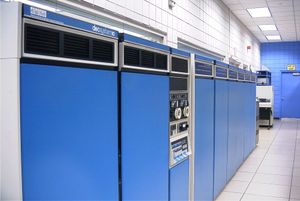Difference between revisions of "PDP-10"
(→See Also) |
(Refactor, fix links) |
||
| Line 1: | Line 1: | ||
| − | [[Image: | + | [[Image:PDP-10 1090.jpg|300px|rightt|thumb|A PDP-10 1090]] |
| − | A series of large, 36-bit [[mainframe]]-like systems built by [[DEC]]; they were basically a re-implementation of the earlier [[PDP-6]] architecture, whose engineering had been a failure. (The machines were so similar at the programming level that PDP-6 code could run on a PDP-10.) | + | A series of large, 36-bit [[mainframe]]-like systems built by [[Digital Equipment Corporation|DEC]]; they were basically a re-implementation of the earlier [[PDP-6]] architecture, whose engineering had been a failure. (The machines were so similar at the programming level that PDP-6 code could run on a PDP-10.) |
| − | DEC sold 4 different generations of PDP-10 processors: the [[KA10]], the [[KI10]], the [[KL10]], and the [[KS10]]. The first three were marketed as the [[DECsystem-10]], running the [[TOPS-10]] operating system; the third was also sold as the [[DECSYSTEM-20]], running [[TOPS-20]]. (The varying capitalization was the result of a trademark infringment suit.) | + | DEC sold 4 different generations of PDP-10 processors: the [[KA10]], the [[KI10]], the [[KL10]], and the [[KS10]]. The first three were marketed as the [[DECsystem-10]], running the [[TOPS-10]] [[operating system]]; the third was also sold as the [[DECSYSTEM-20]], running [[TOPS-20]]. (The varying capitalization was the result of a trademark infringment suit.) |
| − | PDP- | + | Two other very important operating systems also ran on PDP-10's: MIT's [[Incompatible Timesharing System|ITS]] (a very advanced system, from whence came [[EMACS]], and much more besides), and [[TENEX]], which DEC later turned into TOPS-20. |
| − | + | [[Image:DECsystem-10 ad.jpg|150px|left|thumb|PDP-10 ad]] | |
| − | + | PDP-10s were very important machines on the early Internet, being one of the few (relatively!) cheaply available machines which could run a full NCP and later TCP/IP stack as a multi-user environment at the time. | |
| − | |||
| − | |||
| − | + | They still have a large following today. There are several good[[simulator]]s available, notably [[SIMH]] and [[KLH10]]. | |
| − | |||
| − | |||
| − | |||
| − | == | + | ==External links== |
| − | * [ | + | * [http://www.avanthar.com/healyzh/decemulation/pdp10emu.html The DEC PDP-10 Emulation Webpage] |
| − | + | * [http://pdp10.nocrew.org/gcc/ PDP-10 support for GCC] | |
| − | * | ||
[[Category:Computers]] | [[Category:Computers]] | ||
[[Category:DEC Computer Systems]] | [[Category:DEC Computer Systems]] | ||
Revision as of 19:05, 24 October 2017
A series of large, 36-bit mainframe-like systems built by DEC; they were basically a re-implementation of the earlier PDP-6 architecture, whose engineering had been a failure. (The machines were so similar at the programming level that PDP-6 code could run on a PDP-10.)
DEC sold 4 different generations of PDP-10 processors: the KA10, the KI10, the KL10, and the KS10. The first three were marketed as the DECsystem-10, running the TOPS-10 operating system; the third was also sold as the DECSYSTEM-20, running TOPS-20. (The varying capitalization was the result of a trademark infringment suit.)
Two other very important operating systems also ran on PDP-10's: MIT's ITS (a very advanced system, from whence came EMACS, and much more besides), and TENEX, which DEC later turned into TOPS-20.
PDP-10s were very important machines on the early Internet, being one of the few (relatively!) cheaply available machines which could run a full NCP and later TCP/IP stack as a multi-user environment at the time.
They still have a large following today. There are several goodsimulators available, notably SIMH and KLH10.

